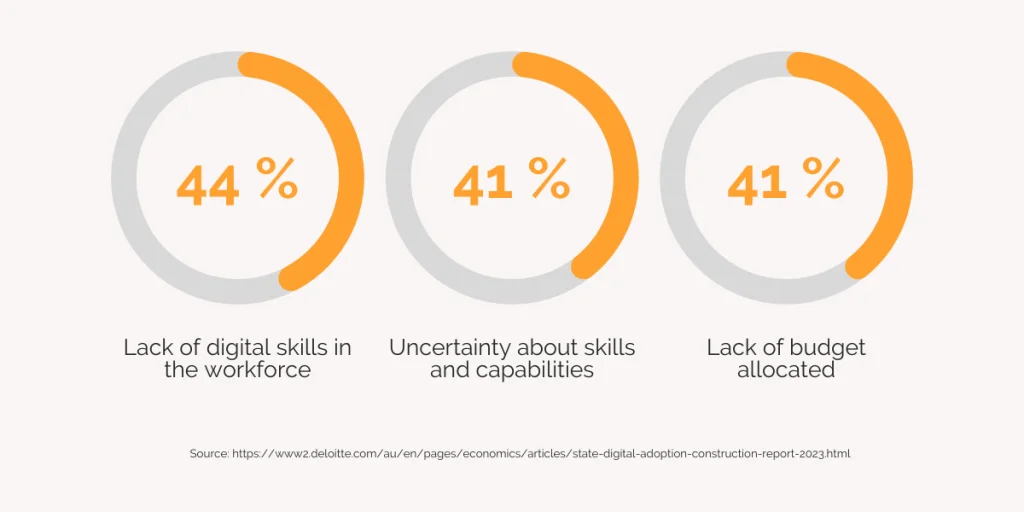Overcoming Barriers to Digital Adoption in Construction and Engineering: Insights from Autodesk Report

Share this post
About the survey
Deloitte Access Economics, commissioned by Autodesk, conducted an analysis of digital adoption trends and industry impacts in the construction and engineering sectors across Australia, Japan, and Singapore. Amidst challenges like COVID lockdowns and global inflation, successful technology implementation has emerged as a crucial factor for businesses to navigate these obstacles. Among 16 construction technologies surveyed, Business Information Modelling (BIM) emerged as the most commonly used, followed closely by cloud management software. The report highlights benefits such as increased productivity, improved customer experience, and enhanced staff safety for businesses leveraging technology. Furthermore, businesses adopting additional technologies were found to experience a significant 0.58 percentage points increase in revenue over the next five years. Notably, the primary barriers to digital adoption were identified as a lack of digital skills in the workforce, uncertainty regarding skills and capabilities, and insufficient budget allocation. To address these obstacles, the report recommends businesses focus on developing organization-wide strategies and building motivation for change, among other key priority areas.
The Barriers to Adopt Digital Construction and Technologies
Autodesk reports that the most common barriers to adopting digital technology was the following:

To address these common barriers, the Autodesk report recommends business to focus on progressing on five key priority areas. Let’s explore the five priority areas identified in the report.
How to Overcome Those Barriers
Develop an organization-wide strategy and track progress:
Creating a comprehensive strategy is crucial for businesses to build digital capabilities within defined timelines and allocated budgets. Setting clear goals and tracking progress allows for a gradual integration of digital technologies and innovation. Businesses with an organization-wide strategy are more likely to introduce new innovations in their operations.
Build motivation for change and implement a robust change management plan:
For digital tools to be effective, active acceptance and use by team members are essential. Understanding users’ perspectives, assessing potential technologies, and articulating transformation benefits at all levels help build enthusiasm for new technologies. Implementing a solid change management strategy, including skill development and transition support, is vital for successful adoption.
Develop in-house digital skills:
Attracting and retaining team members with digital skills is crucial to fully harnessing technology’s potential. Effective training programs significantly impact the success of digitization efforts. Businesses that prioritize skill development are more likely to report a high impact from digital adoption in their operations.
Partner with trusted advisers:
Collaborating with expert technology providers can be invaluable on the digital transformation journey. Trusted advisers offer guidance on the latest technology trends, assist with understanding potential risks, and address interoperability challenges. Partnering saves time and provides a broader perspective on digital technology adoption approaches.
Focus on business outcomes of digital adoption strategies and investments:
Identifying key business outcomes and objectives is essential before evaluating technology investments. By aligning technology with desired goals, businesses can avoid getting distracted by flashy innovations that may not deliver tangible benefits. For instance, cloud construction management software can improve ecosystem relationships, financial health, and regulatory compliance. Utilizing analytics and a Common Data Environment drives efficiencies and supports sustainability goals.
Conclusion
Drawing insights from the Autodesk report, construction and engineering businesses can overcome barriers to digital adoption by implementing the recommended strategies. By developing a comprehensive strategy, fostering motivation for change, investing in in-house digital skills, partnering with trusted advisers, and focusing on business outcomes, businesses can successfully navigate the digital transformation journey. Embracing these recommendations will position organizations for enhanced productivity, improved quality, and sustainable growth in the evolving industry landscape.
About GAMMA AR
GAMMA AR is a Construction App that brings BIM models to the construction site using Augmented Reality. Check out the features of the software and start your 30-day free trial now.
If you have any questions or need support, send us an email at info@gamma-ar.com
